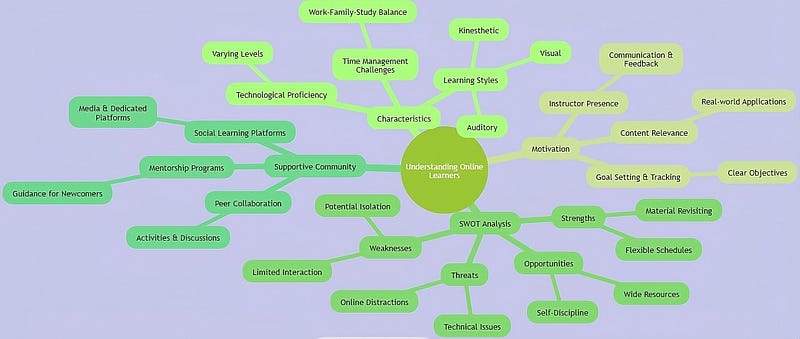Strategies for Engagement in Online Training and Learning
Strategies for Engagement in Online Training and Learning
Introduction
Online learning presents challenges related to diverse learning styles, time management, and technological proficiency. Instructors can boost student engagement by linking course content to real-world applications, providing regular feedback, and setting clear objectives. Interactive course design, including multimedia integration and gamification, enhances the learning experience. Instructors can further promote engagement through dynamic communication, a positive learning environment, and collaborative learning. Fostering self-regulated learning involves metacognitive strategies, feedback, resilience, and holistic well-being. Practical strategies like personalizing interactions, creating videos, and tracking performance contribute to a supportive online learning environment.
Understanding Online Learners

Characteristics of Online Learners:
- Diverse Learning Styles — Varying preferences for visual, auditory, and Kinesthetic learning. Requires diverse instructional approaches.
- Time Management Challenges — Balancing work, family, and study commitments. Significant impact on engagement.
- Technological Proficiency — Varying levels of comfort and proficiency with technology. Affects interaction with online learning platforms.
Motivating Online Learners
- Relevance of Content — Connecting course content to real-world applications. Enhances motivation among online learners.
- Instructor Presence — Regular communication and feedback foster connection and motivation
- Goal Setting and Progress Tracking — Clear learning objectives and progress-tracking tools enhance motivation.
SWOT Analysis
- Strengths — Flexibility in learning schedules. Ability to revisit materials for better understanding.
- Weaknesses — Limited face-to-face interaction. Potential feelings of isolation.
- Opportunities — Access to a wide range of resources. Ability to develop self-discipline and time management skills.
- Threats — Distractions from the online environment. Potential technical issues disrupting the learning process.
Building a Supportive Learning Community
- Peer Collaboration — Encouraging collaborative activities and discussions.
- Mentorship Programs — Implementing programs where experienced learners guide newcomers
- Social Learning Platforms — Utilizing social media or dedicated learning platforms for interactions. Interactive Course Design
Multimedia Integration
- Visual and Audio Content — Incorporating videos, podcasts, and interactive visuals.
- Interactive Assessments — Using quizzes, polls, and interactive assignments.
- Simulations and Virtual Labs — Providing hands-on practice through virtual simulations.
Gamification
- Incorporating Game Elements — Introducing points, badges, and leaderboards.
- Progress Tracking — Using indicators of achievement for continued engagement.
- Competition and Collaboration — Creating opportunities for friendly competition and collaboration.
Personalized Learning Paths
- Adaptive Learning Platforms — Tailoring content based on individual preferences and performance.
- Self-Paced Modules — Offering modules accommodating diverse learning speeds.
- Feedback and Recommendations — Providing personalized feedback and content recommendations.
Real-World Applications
- Case Studies and Scenarios — Integrating real-world examples for practical relevance.
- Industry Projects — Collaborating with industry partners for real-world experiences.
- Community Involvement — Involving learners in community-based projects for meaningful applications.
Instructor Strategies for Engagement

Dynamic Communication
- Interactive Webinars and Discussions — Hosting live webinars for real-time engagement.
- Prompt Feedback — Providing timely and constructive feedback.
- Virtual Office Hours — Offering regular one-on-one discussions for support.
Cultivating a Positive Learning Environment
- Encouraging Open Communication — Creating a supportive and inclusive environment.
- Celebrating Achievements — Recognizing and celebrating learner milestones.
- Embracing Diversity — Valuing diverse perspectives for engagement.
Facilitating Collaborative Learning
- Group Projects and Activities — Assigning collaborative projects requiring teamwork.
- Peer Review and Feedback — Incorporating peer review processes for interaction.
- Virtual Study Groups — Facilitating virtual study groups for peer support.
Continuous Improvement and Adaptation
- Feedback Mechanisms — Implementing surveys for continuous improvement.
- Adapting to Learner Needs — Flexibility in adapting content based on feedback.
- Innovation and Experimentation — Encouraging innovative teaching methods for engagement.
Fostering Self-Regulated Learning
Metacognitive Strategies
- Goal Setting and Planning — Encouraging clear learning goals and study plans.
- Reflective Practices — Promoting journaling and self-assessment for awareness.
- Time Management Skills — Providing resources for effective time management.
Self-Assessment and Feedback
- Self-Monitoring Tools — Provide self-assessment tools for monitoring.
- Guided Reflection — Encouraging reflection on learning experiences.
- Goal Adjustment — Supporting learners in adjusting goals based on feedback.
Building Resilience and Persistence
- Growth Mindset — Fostering resilience in the face of challenges.
- Support Networks — Encouraging seeking support from peers and mentors.
- Celebrating Progress — Recognizing and celebrating incremental progress.
Holistic Well-Being
- Stress Management — Providing resources for stress management.
- Work-Life-Study Balance — Promoting strategies for a healthy balance.
- Mindfulness and Self-Care — Encouraging mindfulness practices for holistic well-being.
References
Northern Illinois University. (n.d.). Recommendations to Increase Student Engagement in Online Courses. Center for Innovative Teaching and Learning. https://www.niu.edu/citl/resources/guides/increase-student-engagement-in-online-courses.shtml
Hurix. (2023, November 16). Top 8 Strategies For Student Engagement In Online Learning. https://www.hurix.com/top-strategies-for-student-engagement-in-online-learning/
eLearning Industry. (2023, April 3). 7 Innovative Teaching Strategies To Engage Students In Online Learning.
In this article, we explore seven innovative teaching strategies to help educators engage their students in online…elearningindustry.com
Livestorm. (2022, February 10). 9 Ways to Improve Student Engagement in Virtual Learning. https://livestorm.co/blog/student-engagement-online-learning
WBT Systems. (n.d.). 9 Ways to Increase Online Student Engagement. Learning Hub. https://www.wbtsystems.com/learning-hub/blogs/9-ways-to-increase-online-student-engagement